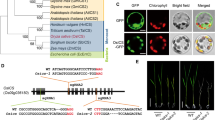Summary
Homozygote plants for the (S) self-incompatibility gene have been produced in Brassica campestris L. var. ‘T 15’. Stigmas from plants designated S 1 S 1, S 2 S 2 and S 4 S 4 were extracted and their protein separated on an isoelectric focusing mini-gel. Differences were observed between proteins from stigmas of the three S-homozygous groups: S-genotype specific proteins were determined for S 1 S 1 and S 2 S 2 stigmas that were absent in the self-compatible S 4 S 4 stigmas. Carbon dioxide (CO2), which is known to block the self-incompatibility reaction in Brassica, was applied to [35S]-methionine unpollinated, self- and cross-pollinated stigmas to observe the effect of external CO2 on the synthesis of these S-associated proteins. The results indicate that pollination triggers a dramatic reduction in protein synthesis in general and in the synthesis of S2-associated protein after self-pollination in particular.
Similar content being viewed by others

References
Anderson MA, Cornish EC, Mau SL, Williams EG, Hoggart R, Atkinson A, Bonig I, Grego B, Simpson R, Roche PJ, Haley JD, Penschow JD, Niall HD, Tregear GW, Coglan JP, Crawford RJ, Clarke AE (1986) Cloning of cDNA for a stylar glycoprotein associated with expression of self-incompatibility in Nicotiana alata. Nature 321:38–44
Bateman AJ (1955) Self-incompatibility systems in angiosperms. III. Cruciferae. Heredity 9:53–68
Clarke AE, Anderson MA, Bacic T, Harris PJ, Mau SL (1985) Molecular basis of cell recognition during fertilisation in higher plants. J Cell Sci [Suppl] 2:261–285
Dumas C, Knox RB (1983) Callose and determination of pistil viability and incompatibility, Theor Appl Genet 67:1–10
Hinata K (1981) Self-incompatibility: physiological aspects for the breeding of cruciferous vegetables. In: Talekar NS, Griggs TD (eds) Chinese cabbage. Asian Vegetable Research and Development Centre, Shanhua, Taiwan, pp 321–334
Hinata K, Nishio T (1980) Self-incompatibility in Crucifers. In: Tsunoda S, Hinata K, Gomez-campo C (eds) Brassica crops and wild allies. Japan Scientific Societies Press, Tokyo, pp 223–234
Hinata K, Nishio T, Kimura J (1982) Comparative studies on S-glycoproteins purified from different S-genotypes in self-incompatible Brassica species. II. Immunological specificities. Genetics 100:649–657
Isogai A, Takayama S, Tsukamoto C, Ueda Y, Shiozawa H, Hinata K, Okazak K, Suzuki A (1987) S-locus-specific glycoproteins associated with self-incompatibility in Brassica campestris. Plant Cell Physiol 28:1279–1291
Kamboj RK, Jackson JF (1986) Self-incompatibility alleles control a low molecular weight, basic protein in pistils of Petunia hybrida. Theor Appl Genet 71:815–819
Kheyr-pour A, Pernes J (1986) A new S-allele and specific S-proteins associated with two S-alleles in Nicotiana alata. In: Mulcahy DL, Mulcahy GB, Ottaviano E (eds) Biotechnology and ecology of pollen. Springer, New York Berlin Heidelberg, pp 191–196
Mackay GR (1977) A diallel cross method for the recognition of S-allele homozygotes in turnip, Brassica campestris L. ssp. rapifera. Heredity 38:201–208
Mau SL, Raff J, Clarke AE (1982) Isolation and partial characterisation of components of Prunus avium L. styles, including an antigenic glycoprotein associated with a self-incompatibility genotype. Planta 156:505–516
Mitz MA (1979) CO2 biodynamics: a new concept of cellular contol. J Theor Biol 80:537–551
Nasrallah JB, Doney RC, Nasrallah ME (1985) Biosynthesis of glycoproteins involved in the pollen-stigma interaction of incompatibility in developing flowers of Brassica oleracea L. Planta 165:100–107
Nasrallah JB, Kao T-H, Chen C-H, Goldberg ML, Nasrallah ME (1987) Amino acid sequence of glycoproteins encoded by three alleles of the S locus of Brassica oleracea. Nature 326:617–619
Nasrallah ME (1974) Genetic control of quantitative variation in self-incompatibility proteins detected by immunodiffusion. Genetics 76:45–50
Nasrallah ME, Barber JT, Wallace DH (1970) Self-incompatibility proteins in plants: detection, genetics and possible mode of action. Heredity 25:23–27
Nasrallah ME, Wallace DH, Savo RM (1972) Genotype, protein, phenotype relationships in self-incompatibility in Brassica. Genet Res 20:151–160
Nishio T, Hinata K (1977) Analysis of S-specific proteins in stigma of Brassica oleracea L. by isoelectric focussing. Heredity 38:391–396
Nishio T, Hinata K (1982) Comparative studies on S-glycoproteins purified from different S-genotypes in self-incompatible Brassica species. I. Purification and chemical properties. Genetics 100:641–647
Ockendon DJ (1975) Dominance relationship between S-alleles in the stigmas of brussel sprouts (Brassica oleracea var. ‘gemmifera’). Euphytica 24:165–172
O'Neill PM (1988) Aspects of the reproductive biology of Brassica campestris L. MSc thesis, University of Melbourne
O'Neill PM, Singh MB, Neales TF, Knox RB, Williams EG (1984) Carbon dioxide blocks the stigma callose response following incompatible pollinations in Brassica. Plant Cell Environ 7:285–288
O'Neill PM, Singh MB, Knox RB (1988) Cell biology of the stigma of Brassica campestris in relation to CO2 effects on self-pollination. J Cell Sci 89:541–549
Takayama S, Isogai A, Tsukamoto C, Ueda Y, Hinata K, Okazaki K, Suzuki A (1987) Sequences of S-glycoproteins, products of the Brassica campestris self-incompatibility locus. Nature 326:102–105
Taylor JP (1982) Carbon dioxide treatment as an effective aid to the production of selfed seed in kale and Brussels sprouts. Euphytica 31:957–964
Thompson KF (1978) Application of recessive self incompatibility to production of hybrid rape seed (abstract). 5th International Rape Seed Conference, Malmö 1978
Thompson KF, Howard HW (1959) Self-incompatibility in marrow-stem kale, Brassica oleracea var. ‘acephala’. II. Methods for the recognition in inbred lines of plants homozygous for S alleles. J Genet 56:325–340
Author information
Authors and Affiliations
Rights and permissions
About this article
Cite this article
O'Neill, P.M., Singh, M.B. & Knox, R.B. Biosynthesis of S-associated proteins following self- and cross-pollinations in Brassica campestris L. var. ‘T. 15’. Sexual Plant Reprod 2, 103–108 (1989). https://doi.org/10.1007/BF00191998
Issue Date:
DOI: https://doi.org/10.1007/BF00191998



